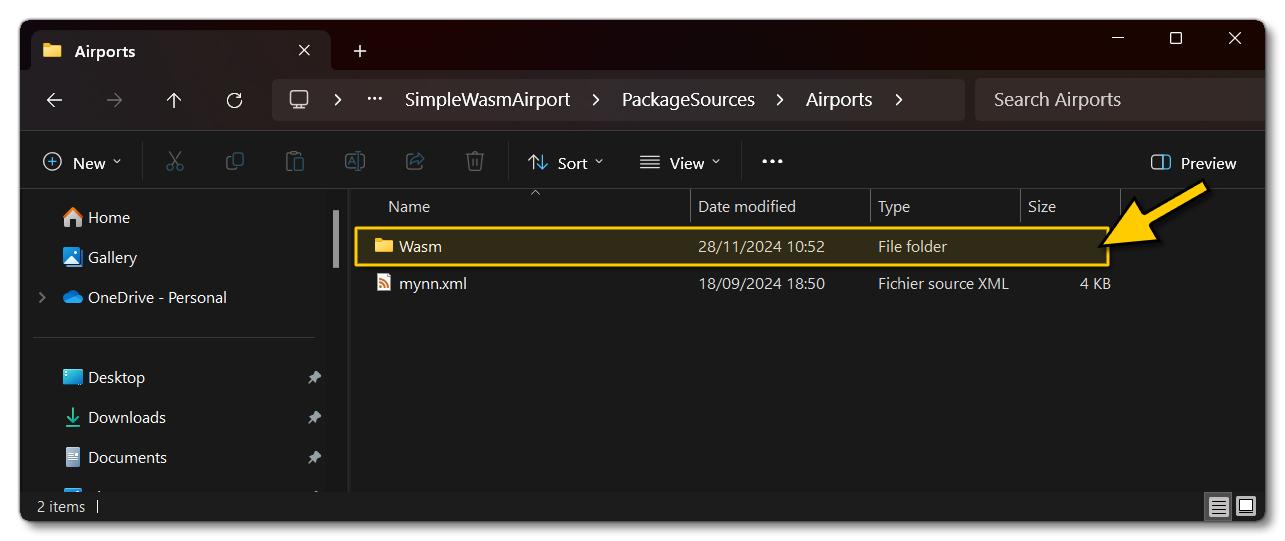CREATING WASM AIRPORTS
In Microsoft Flight Simulator 2024 it is possible to WebAssembly modules (WASM) to your airports. These are essentially System Modules that don't render anything to the screen, but are used to process data relevant to the operation of the airport. For example, simulate a control tower or spawn VFX, like fireworks, when a plane lands. It is worth noting that another benefit of using an airport WASM is that they have a much better performance than the other available solution - standalone modules. This is because standalone modules are always loaded, while airport modules are loaded only when needed and then unloaded when no longer needed.
Creating The Module
The system module for the airport is created in the same way that you would create any WebAssembly module, and the process is outlined here:
Within the module, the minimum includes that you'll need are as follows:
#include "MSFS/MSFS.h" // for MSFS_CALLBACK macro and Debug
#include "MSFS/MSFS_AirportContext.h" // For FsWasmAirportContext struct
The rest of the code required will depend on the operations that you wish to perform, but it's important to be aware of the callbacks that are generated by the simulation, as these will be essential for your module. To see examples of how these callbacks are used, please check the following SDK sample project:
FsWasmAirportContext
This isn't exactly a callback - it's a struct - but it is sent back to the module from every callback, and as such it's very important since it defines the context of the callback information:
#define WASM_AIRPORT_ICAO_SIZE 18
typedef struct {
char ICAO[WASM_AIRPORT_ICAO_SIZE];
} FsWasmAirportContext;This struct has an ICAO member which will contain the ICAO code of the airport. This is usually 4 characters long, but can be up to 8 to cover special cases.
AirportInit
When an airport is instantiated, this callback is sent to let the WASM know the airport is ready:
bool AirportInit(
FsWasmAirportContext* ctx
);This callback is sent the very first frame that the module is initialised, and it contains the airport context ctx. The call back will return true if the instantiation has been done correctly, otherwise it will return false if there is an error.
AirportUpdate
After instatiation the following callback is sent every frame:
bool AirportUpdate(
FsWasmAirportContext* ctx,
float dTime
);The callback contains the airport context ctx, the delta time dTime, ie: the time elapsed since the last frame. The call back will return true if everything is correct, otherwise it will return false.
AirportKill
The following callback is sent when the airport is "killed" (ie: the instance is removed from the simulation because the user aircraft has moved far enough away):
bool AirportKill(
FsWasmAirportContext* ctx
);The callback contains the airport context ctx that has been killed, and will return true if the execution of the "kill" has been done correctly, otherwise it will return false if there is has been an error.
Additional Information
It should be noted that:
- An airport can reference several WebAssembly modules, and they will all be executed.
- The same module can be executed by different airports, but note that this execution will not be in parallel, and that the allocated memory will be shared among all of them.
- For airport specific data - especially if a module is shared between several airports - you should always use the ICAO code to ensure the data retrieved is for the correct airport.
The Airport Package
When it comes to setting up the airport to access the WASM, this is done in two stages. The first is to add the relevant files to the package itself. If you haven't got the airport package setup, this is explained here:
Once you have your module files, these need to be added into a wasm folder at the top level of the airport package beside the airport XML file, eg:

Once you have added the files, you need to link them with the airport so that they will run when the airport is instantiated. This is done from The Scenery Editor, using the WASM Module section of airport object. In this section you simply add the path to the *.wasm file of the module, and if you have multiple modules for the airport then they can all be added here.
NOTE: the path shown in the editor is output path for the final package not the source path.
If there are any issues with the module (not with the code it contains, but with the package setup), these will be flagged in the editor, for example:
